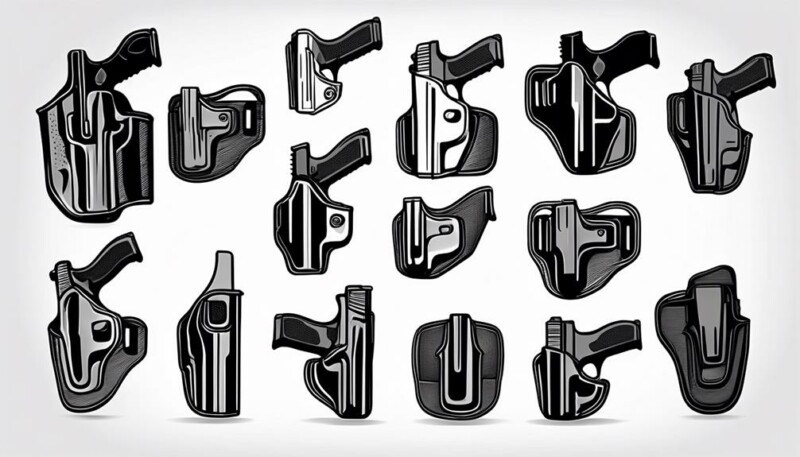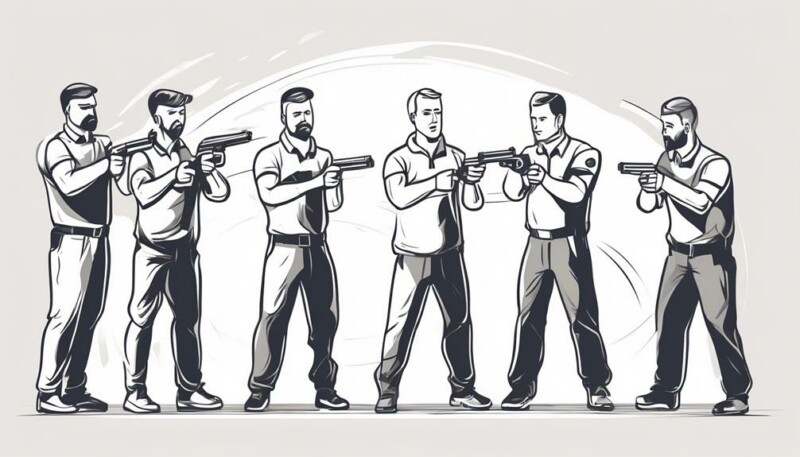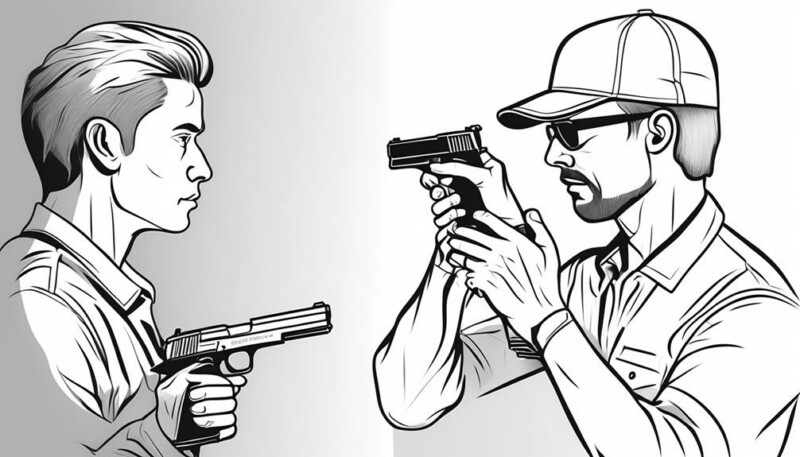Imagine this scenario: You've just obtained your concealed carry permit and are excited to start carrying your firearm for personal protection.
However, it's crucial to remember that carrying a concealed firearm comes with immense responsibility. To ensure the safety of yourself and those around you, it's essential to undergo proper firearm safety training.
In this discussion, we will explore seven key tips that will help you navigate the world of concealed carry, from understanding the laws to developing a concealed carry mindset.
By following these tips, you'll be equipped with the knowledge and skills necessary to responsibly exercise your right to carry a concealed firearm.
So, let's dive in and discover how you can enhance your concealed carry firearm safety training.
Key Takeaways
- Familiarize yourself with the concealed carry laws in your state to avoid serious consequences.
- Always treat every firearm as if it's loaded and keep the muzzle pointed in a safe direction.
- Proper training is crucial to understand and adhere to essential firearm safety rules.
- Choose the right firearm for concealed carry based on factors like concealability, reliability, and practical accuracy.
Understanding Concealed Carry Laws
If you're considering carrying a concealed firearm, it's essential to have a solid understanding of the laws that govern this practice. Knowing the laws not only keeps you on the right side of the legal system, but it also ensures the safety of yourself and those around you.
Before you even think about carrying a concealed gun, take the time to research and familiarize yourself with the laws in your state. Each state has its own specific regulations regarding the carry of firearms, including where you can carry, when you can use deadly force, and any required permits or licenses. Ignorance of these laws isn't an excuse and can lead to serious consequences.
It's important to remember that the purpose of concealed carry laws is to protect both the carrier and the general public. By adhering to these laws, you can ensure that you're responsibly exercising your right to carry a concealed firearm. So, take the time to educate yourself, attend any necessary training courses, and stay informed about any changes in the laws.
Your safety and the safety of others depend on it.
Essential Firearm Safety Rules
When it comes to firearm safety, there are a few essential rules that you must always follow.
First and foremost, treat every firearm as if it's loaded, regardless of whether you believe it to be unloaded.
Secondly, keep the muzzle pointed in a safe direction at all times, away from yourself and others.
And finally, always keep your finger off the trigger until you're ready to shoot.
These fundamental safety principles are crucial in handling firearms responsibly, and it's imperative to receive proper training to ensure you understand and adhere to these rules.
Fundamental Safety Principles
Always treat a concealed firearm as if it is loaded, regardless of your belief about its current state. This is one of the fundamental safety principles that should always be followed when carrying a firearm. To ensure the safety of yourself and those around you, it is important to adhere to a set of safety rules. Here are some essential firearm safety rules to keep in mind:
| Fundamentals of Firearm Safety |
|---|
| Never point the muzzle at anything you are not willing to shoot and potentially destroy. |
| Keep your finger off the trigger and outside the trigger guard until you are ready to shoot. |
| Be absolutely sure of your target and what is beyond it to prevent unintended harm. |
| Always use a high-quality holster that fully protects the trigger. |
| Handle your firearm only when necessary and in a safe location. |
Following these safety rules will help you ensure the well-being of yourself and those around you. It is crucial to be aware of and abide by the firearm laws in your area to avoid any legal issues. Remember, responsible concealed carry is about prioritizing safety at all times.
Handling Firearms Responsibly
To handle firearms responsibly and ensure the safety of yourself and those around you, it's crucial to adhere to a set of essential firearm safety rules.
- Always treat every firearm as if it's loaded, even if you personally verified it's not.
- Never point the muzzle at anything you aren't willing to shoot and destroy.
- Keep your finger off the trigger and outside the trigger guard until you're ready to shoot.
- Be sure of your target and what's beyond it to avoid unintended harm.
- Select a high-quality holster that protects the trigger.
- Only handle your firearm when necessary and in a safe location.
Importance of Proper Training
Proper training is essential for mastering the essential firearm safety rules and ensuring the responsible handling of firearms. When it comes to carrying a concealed firearm, safety should always be the top priority. A comprehensive firearm safety training program will equip you with the knowledge and skills needed to handle a firearm without compromising the safety of yourself and others.
Here are four key reasons why proper training is so important:
- Cover garment: Training teaches you how to effectively and safely draw your firearm from under a cover garment, minimizing the risk of accidental discharge.
- Trigger control: Proper training emphasizes the importance of maintaining proper trigger control, preventing unintentional shots from being fired.
- Emergency situations: Training prepares you for high-stress scenarios, enabling you to make quick and informed decisions to protect yourself and others.
- Legal responsibilities: A good training program educates you about the legalities surrounding concealed carry, ensuring you understand your rights and responsibilities.
Choosing the Right Firearm for Concealed Carry
When choosing the right firearm for concealed carry, it's important to consider factors such as concealability, reliability, controllability, and practical accuracy.
The best gun for carrying a concealed firearm is one that you can effectively hide on your person without drawing attention. Look for a compact and lightweight handgun that can easily fit in a holster or on a gun belt.
Additionally, ensure that the firearm is reliable and has consistent firing capabilities. You want a gun that you can depend on in any situation.
Controllability is also crucial, as you need to be able to handle and operate the firearm effectively. Consider the accessibility of the controls, such as the safety and slide release, to ensure ease of use.
Practical accuracy is another important aspect to consider. Look for a firearm that allows for accurate shooting within realistic engagement ranges. Pay attention to the quality of the sights and trigger, as these can greatly impact your ability to hit your target.
Remember to always check and comply with your local laws regarding carrying a gun and choose a good holster that securely holds your firearm in place.
Proper Holster Selection and Carry Methods

When it comes to concealed carry, selecting the right holster is crucial. There are different types of holsters to choose from, such as inside-the-waistband or appendix carry, each with its own advantages and considerations.
You should also take into account your clothing options and body type to ensure a proper fit and easy concealment. By selecting a subtle and comfortable holster that suits your needs and style, you can carry your firearm discreetly and securely.
Holster Types Explained
To ensure the safety and effectiveness of your concealed carry firearm, it's crucial to select a holster that covers the trigger-guard and meets your individual preferences and needs. Choosing the right holster is essential for safe concealed carrying.
Here are some key points to consider when selecting a holster:
- Test different holsters to find the one that suits your preferences and provides proper trigger guard coverage.
- Consider factors such as your body type, clothing style, and physical characteristics when selecting a holster.
- Opt for a holster that allows for easy concealment, so you can carry your firearm discreetly.
- Research different types of holsters, such as inside-the-waistband or outside-the-waistband options, to find the one that suits your needs best.
Consider Clothing Options
Consider your clothing options when selecting a proper holster and carry method to ensure comfort, concealment, and effective concealed carry. It's important to choose a holster that suits your needs and attire.
Take into account your body type, clothing style, and physical characteristics. This will enable you to achieve effective concealment while also being comfortable and secure.
Regularly practice drawing your firearm from the holster to ensure quick and efficient access during emergencies. Familiarize yourself with the specific concealed carry laws in your state and stay updated on any changes or updates.
When it comes to clothing, consider wearing tactical pants which are designed with features like reinforced belt loops and extra pockets to accommodate your concealed carry needs.
Appendix carry and waistband (OWB) holsters are popular carry methods, but regardless of the method, always ensure that the holster covers the trigger to prevent accidental discharge.
Importance of Proper Fit
Choosing a properly fitting holster is essential for ensuring the secure retention and comfortable carry of your firearm. When it comes to selecting the right holster, there are a few key factors to consider.
- Body type: Choose a holster that matches your body type to ensure a snug fit and prevent any unnecessary movement or discomfort.
- Clothing style: Consider your clothing style and how it will affect your holster choice. Opt for a holster that can be easily concealed without compromising accessibility.
- Holster position: Experiment with different positions to find the one that works best for you. Whether it's appendix carry, hip carry, or small of the back, find what allows for quick and easy access while maintaining concealment.
- Retention and trigger guard: Prioritize holsters that cover the trigger guard and offer secure retention. This will prevent any accidental discharges and keep your loaded gun safe.
Importance of Regular Training and Practice

Regular training and practice are essential for maintaining proficiency and confidence in using your concealed carry firearm. Consistent practice helps develop muscle memory and ensures that you can respond properly in high-stress situations. It also allows you to stay familiar with your firearm and its operation, enhancing both safety and effectiveness. Practicing regularly hones your marksmanship skills, improving your accuracy and reducing the risk of unintended harm. Moreover, ongoing training ensures that you are up to date with the latest techniques, laws, and safety protocols related to carrying concealed.
To further emphasize the importance of regular training and practice, let's take a closer look at the pros and cons:
| Pros | Cons |
|---|---|
| Enhances proficiency | Requires time and commitment |
| Builds confidence | Can be costly |
| Develops muscle memory | Can be physically demanding |
| Improves marksmanship skills | May cause wear on your holster |
Make sure you allocate dedicated time to practice regularly, even if it's just dry firing without ammunition. This allows you to practice drawing from your holster, aiming, and manipulating the firearm safely. Additionally, it's important to know that regular training not only helps you become proficient with your firearm but also keeps you mentally prepared and aware of the responsibilities that come with carrying concealed.
Maintaining Your Firearm for Optimal Safety
Now that you understand the importance of regular training and practice, it's crucial to shift our focus to maintaining your firearm for optimal safety. Keeping your firearm in top condition ensures that it functions properly when you actually need to use it. Here are some key tips to help you maintain your firearm effectively:
- Clean your firearm regularly: Cleaning your firearm is essential to prevent dirt, debris, and rust from compromising its performance. Follow the manufacturer's recommendations for cleaning products and techniques.
- Inspect your firearm after each use: After firing your gun, take the time to inspect it thoroughly. Look for any signs of wear or damage, such as loose screws or malfunctioning parts. Replace any worn-out or damaged components promptly to maintain safety.
- Follow manufacturer recommendations: Each firearm has specific maintenance requirements. Make sure to read and follow the manufacturer's instructions for cleaning, maintenance, and upkeep. This will ensure that you're taking the necessary steps to keep your firearm in optimal condition.
- Seek professional assistance when needed: Some maintenance tasks, like complex repairs or modifications, are best left to professionals. If you encounter any issues that you're unsure how to handle, seek the help of a qualified gunsmith. They have the expertise to ensure your firearm functions properly and safely.
Developing a Concealed Carry Mindset

Develop a proactive and vigilant mindset when carrying a concealed firearm to ensure your safety and the safety of those around you. One of the most important aspects of developing a concealed carry mindset is to pay attention to your surroundings at all times. Situational awareness is crucial in anticipating potential threats and taking the necessary steps to avoid dangerous situations.
It's also essential to familiarize yourself with the laws and regulations regarding concealed carry in your state and any other state you may be traveling to. Knowing your rights and responsibilities as a concealed carry permit holder is crucial for staying on the right side of the law.
Another important aspect of developing a concealed carry mindset is understanding the public perception and potential consequences of carrying a concealed firearm. While it's your right to carry, it's important to consider how others may react to the presence of a firearm. Being discreet and respecting other people's comfort levels is essential for maintaining a positive public image for responsible gun owners.
Developing a concealed carry mindset isn't a one-time thing. It's a commitment to carrying responsibly and continuously improving your everyday carry habits. Regular practice and training are essential to ensure that you're comfortable and proficient with your firearm. It's also important to remember that carrying a concealed firearm is a perishable skill. Without regular practice and training, your skills can diminish over time.
Frequently Asked Questions
What Are the 10 Rules of Gun Safety?
Gun safety is of utmost importance when it comes to responsible firearm handling.
Knowing the 10 rules of gun safety is crucial for anyone engaging in concealed carry or firearm training. These rules encompass various aspects such as safe storage, proper handling, and accident prevention.
By adhering to these rules, you can ensure the safety of yourself and those around you.
What Is the Best Safety for Concealed Carry?
The best safety for concealed carry is a combination of factors.
It starts with choosing the right holster, one that offers proper retention and protects the trigger.
Next, focus on developing a proper grip and practicing trigger discipline.
Situational awareness is key, along with mastering drawing techniques and being mindful of firearm selection.
Incorporating training drills and mindset preparation will also enhance your safety.
What Is the Most Comfortable CCW Method?
Looking for the most comfortable way to carry concealed? Consider options like a shoulder holster, ankle carry, belly band, appendix carry, pocket carry, IWB (Inside the waistband) carry, OWB (Outside the waistband) carry, cross draw, or smart carry.
Each method has its pros and cons, so it's important to find what works best for your body type and lifestyle. Experiment with different holsters and positions until you find the one that provides both comfort and easy accessibility.
Stay safe and confident with your concealed carry.
Should I Conceal Carry With One in the Chamber?
Should you conceal carry with one in the chamber? It's a question that requires careful consideration.
There are pros and cons to carrying with a round in the chamber. It offers a tactical advantage in high-stress situations, but it also requires extensive training and mental preparedness.
You should assess the risks and benefits, and make a decision based on your personal preference and comfort level. Don't forget about the importance of proper holster considerations, situational awareness, and understanding legal considerations.
Conclusion
So, you now understand the importance of concealed carry firearm safety training.
By following these 7 key tips, you can confidently navigate the complexities of concealed carry laws, ensure proper firearm safety, and choose the right equipment for your needs.
Remember, regular training and practice are essential to maintaining your skills, and developing a concealed carry mindset will help you stay prepared and safe.
Don't let the fear of the unknown hold you back.
Take the necessary steps to protect yourself and loved ones responsibly.
